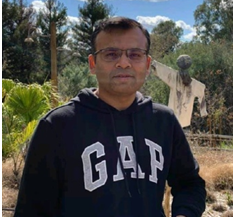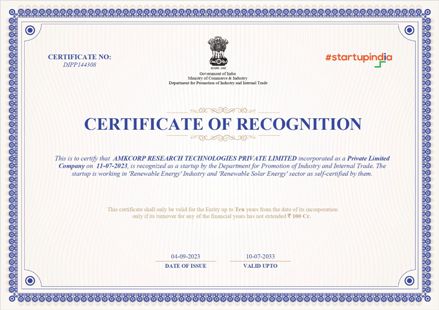
THE SCIENCE OF MACHINE LEARNING
PART 2
AUTHOR(S) -
VARUN SHAH, TARUNA CHOPRA, SHOKHJAKHON ABDUFATTOKHOV, Dr. SOUMI RAY
DOI – 10.61909/AMKEDTB022412
Genre/Subject – Computer Science, ML, AI
Series – Machine Learning
Book code – AMKEDTB022412
ISBN(P) – 978-81-970871-7-2
ISBN(E) – 978-81-970871-4-1
Publication Date – 29-02-2024
AUTHOR(S)

VARUN SHAH
Mr. Varun Shah, a seasoned IT professional and leader residing in San Francisco, California, has an extensive background in the computer science field, boasting over 16 years of experience. Currently employed at Amazon, he obtained his Bachelor’s Degree in Information Technology from L.D. College of Engineering, Gujarat University in 2007. Throughout his career, he has honed his skills in various areas, including Artificial Intelligence, Machine Learning, Cloud Computing, Database Management, Cyber Security, and Data Processing. Always striving to stay ahead of the curve, he consistently updates his knowledge to adapt to the ever-changing IT landscape. In addition to his technical expertise, he actively embraces professional development, fostering a culture of continuous learning. With a proven track record of leading successful initiatives and collaborating with diverse teams, he is driven to utilize his wealth of knowledge and experience to fuel innovation within the dynamic realm of Information Technology.

TARUNA CHOPRA
Ms. Taruna Chopra is currently working as an Assistant Professor in the School of Computer Applications, Manav Rachna International Institute of Research and Studies, Faridabad. She is UGC NET QUALIFIED and has a rich teaching experience of 15+ years in reputed universities and colleges including Kalinga University, Rungta College of Engineering and Technology, Maharaja Agrasen International College. She is currently pursuing her Ph.D from Kalinga University, Raipur. She obtained her Masters in Computer Applications from Government Engineering College, Raipur. Her research areas include Internet of Things, Virtual Reality and Augmented Reality. She has published many research papers in various national and international journals . She has attended several conferences, workshops and seminars on Data analysis, IOT etc.

SHOKHJAKHON ABDUFATTOKHOV
Mr. Shokhjakhon Abdufattokhov was born on October 20, 1992 in Andijan, Uzbekistan. In 2011, he entered to Turin Polytechnic University in Tashkent and earned BSc degree with distinction of Mechanical Engineering in 2015. From 2015 to 2016, he worked as an engineer in GM Uzbekistan car plant. Subsequently, he was enrolled in Erasmus Mundus Joint Master Degree Program in Mathematical Modelling in Engineering and successfully defended his thesis in 2018 at University of L’aquila, Italy. He is an associate professor of Automatic Control and Computer Engineering Department in Turin Polytechnic University in Tashkent. He has published more than 30 articles in high impact worldwide journals and conferences. His research interest is in data analysis, predictive modeling, system identification, machine learning and optimal control.

Dr. SOUMI RAY
Dr. Soumi Ray is a distinguished scholar, educator, and researcher, recognized for her profound contributions to the fields of engineering and technology. Born and raised in Midnapore, West Bengal, Dr. Ray exhibited exceptional aptitude in mathematics and physics from a young age, consistently ranking among the top performers in talent tests within her zone.
She pursued her undergraduate studies in Instrumentation Engineering at Haldia Institute of Technology, graduating with honors, and subsequently earned her Master’s degree from Netaji Subhash Engineering College, Kolkata, specializing in MEMs fabrication from CEERI, Pilani. Dr. Ray furthered her academic journey by obtaining her Ph.D. from the esteemed Indian Institute of Technology, Roorkee, where she conducted groundbreaking research in Image Processing for Diagnosis and Treatment within the Electrical Department.
Throughout her career, Dr. Ray has held teaching and research positions at prestigious institutions such as Bengal College of Engineering and Technology (Durgapur, West Bengal), Kalyani Government Engineering College (West Bengal), Amity School of Engineering and Technology (Delhi), and presently serves as a faculty member at Vellore Institute of Technology Vellore. Her expertise and dedication have also been acknowledged during her tenure as a Project Assistant at the National Physical Laboratory (NPL) in New Delhi.
Dr. Ray’s scholarly work has been widely published and cited, underscoring her impact and influence in the academic community. For a comprehensive overview of her research contributions, please visit her Google Scholar profilehere(https://scholar.google.co.in/citations?user=9o4Q-8IAAAAJ&hl=en).
With her extensive expertise and commitment to advancing knowledge, Dr. Soumi Ray continues to inspire and shape the future of engineering and technology through her research, teaching, and mentorship endeavours.
ABOUT BOOK / ABSTRACT
The book titled “The Science of Machine Learning” serves as a comprehensive guide for both beginners and experienced practitioners in the field of machine learning. Covering a wide range of topics, the book provides a thorough introduction to the fundamentals of machine learning, as well as advanced techniques and emerging trends.
In the first chapter, readers are introduced to the concept of machine learning, its historical context, and its importance and applications in various domains. The chapter also explores different types of machine learning and addresses key terminologies, challenges, and limitations associated with the field.
The second chapter delves into the mathematical foundations essential for understanding machine learning algorithms. Topics covered include linear algebra, probability and statistics, calculus, optimization techniques, information theory basics, and numerical methods and algorithms.
Moving forward, the book explores data preprocessing and exploration techniques in Chapter 3. Readers learn about data cleaning, handling missing values, feature scaling, normalization, feature engineering, exploratory data analysis (EDA), data visualization, and dimensionality reduction methods.
Chapters 4 and 5 focus on supervised and unsupervised learning algorithms, respectively. Readers are introduced to popular algorithms such as linear regression, logistic regression, decision trees, random forests, support vector machines (SVM), k-nearest neighbors (k-NN), and ensemble methods for supervised learning, as well as k-means clustering, hierarchical clustering, Gaussian mixture models (GMM), principal component analysis (PCA), t-distributed stochastic neighbor embedding (t-SNE), and association rule learning for unsupervised learning.
Chapter 6 explores neural networks and deep learning, covering topics such as artificial neural networks (ANN), convolutional neural networks (CNN), recurrent neural networks (RNN), long short-term memory (LSTM), and generative adversarial networks (GAN).
In Chapter 7, readers learn about model evaluation and validation techniques, including cross-validation, performance metrics, bias-variance tradeoff, hyperparameter tuning, model interpretability, and explainability.
Chapter 8 focuses on feature selection and model interpretability, discussing the importance of feature selection, techniques for feature selection, interpretable machine learning models, explainable AI (XAI) techniques, model debugging, error analysis, and visualization of model decisions.
Chapters 9 and 10 delve into natural language processing (NLP) and computer vision, respectively, covering topics such as text preprocessing techniques, word embeddings, recurrent neural networks for NLP, transformer models, image preprocessing techniques, convolutional neural networks for image classification, object detection, image segmentation, and transfer learning.
Chapter 11 introduces readers to reinforcement learning, discussing concepts such as Markov decision processes (MDP), Q-learning, policy gradient methods, deep reinforcement learning, and applications of reinforcement learning.
In Chapter 12, readers learn about deploying machine learning models, including model deployment strategies, containerization and orchestration, model serving platforms, monitoring and scaling machine learning systems, ethical considerations in model deployment, and model maintenance and updates.
Finally, Chapter 13 explores future trends and directions in machine learning, including the current state of machine learning research, emerging technologies and innovations, and ethical and societal implications of machine learning. The chapter concludes with final thoughts and reflections on the future of the field.
Overall, “The Science of Machine Learning” provides a comprehensive overview of the field, equipping readers with the knowledge and skills necessary to embark on their journey in machine learning and stay abreast of the latest advancements and trends.








